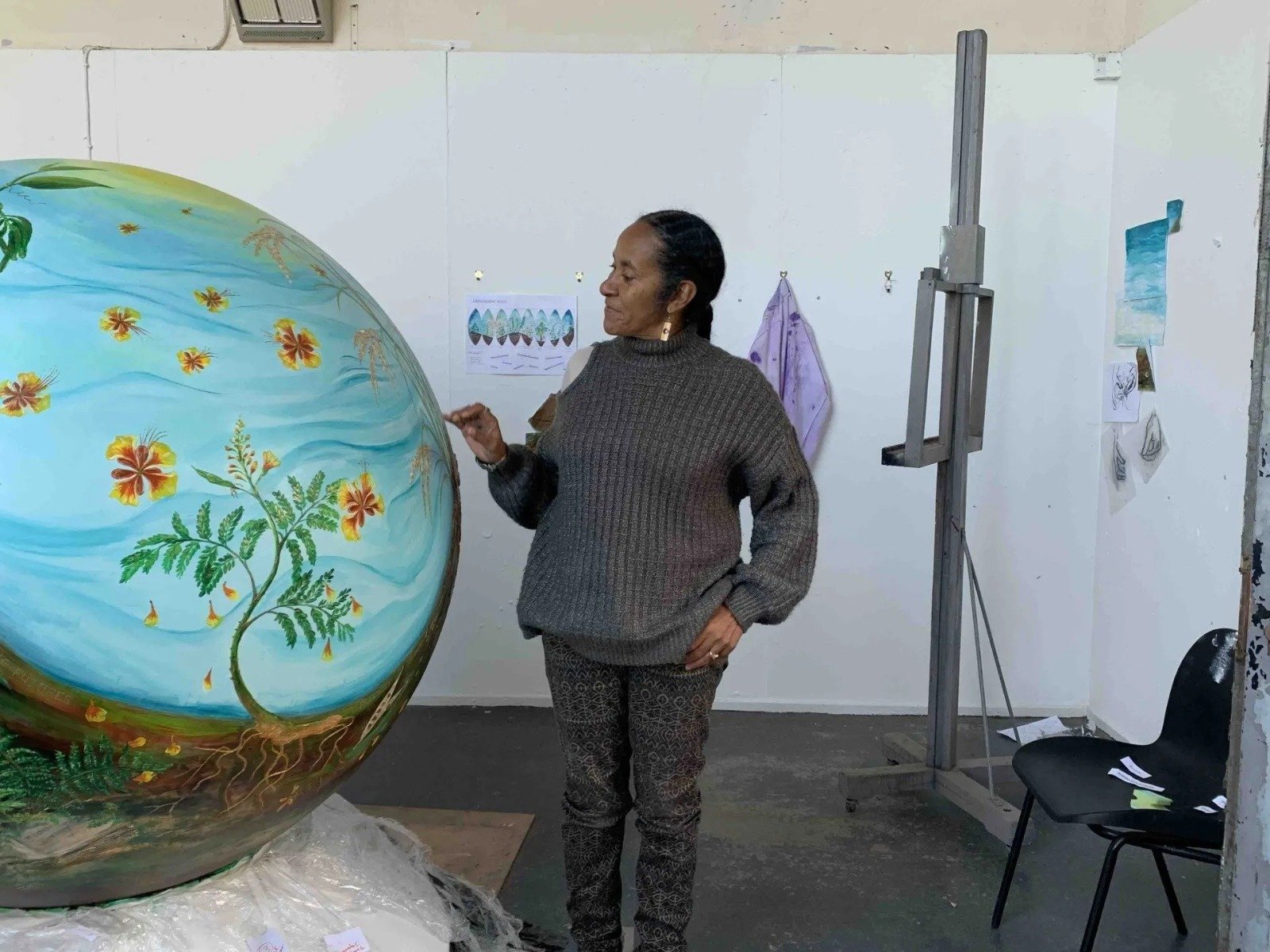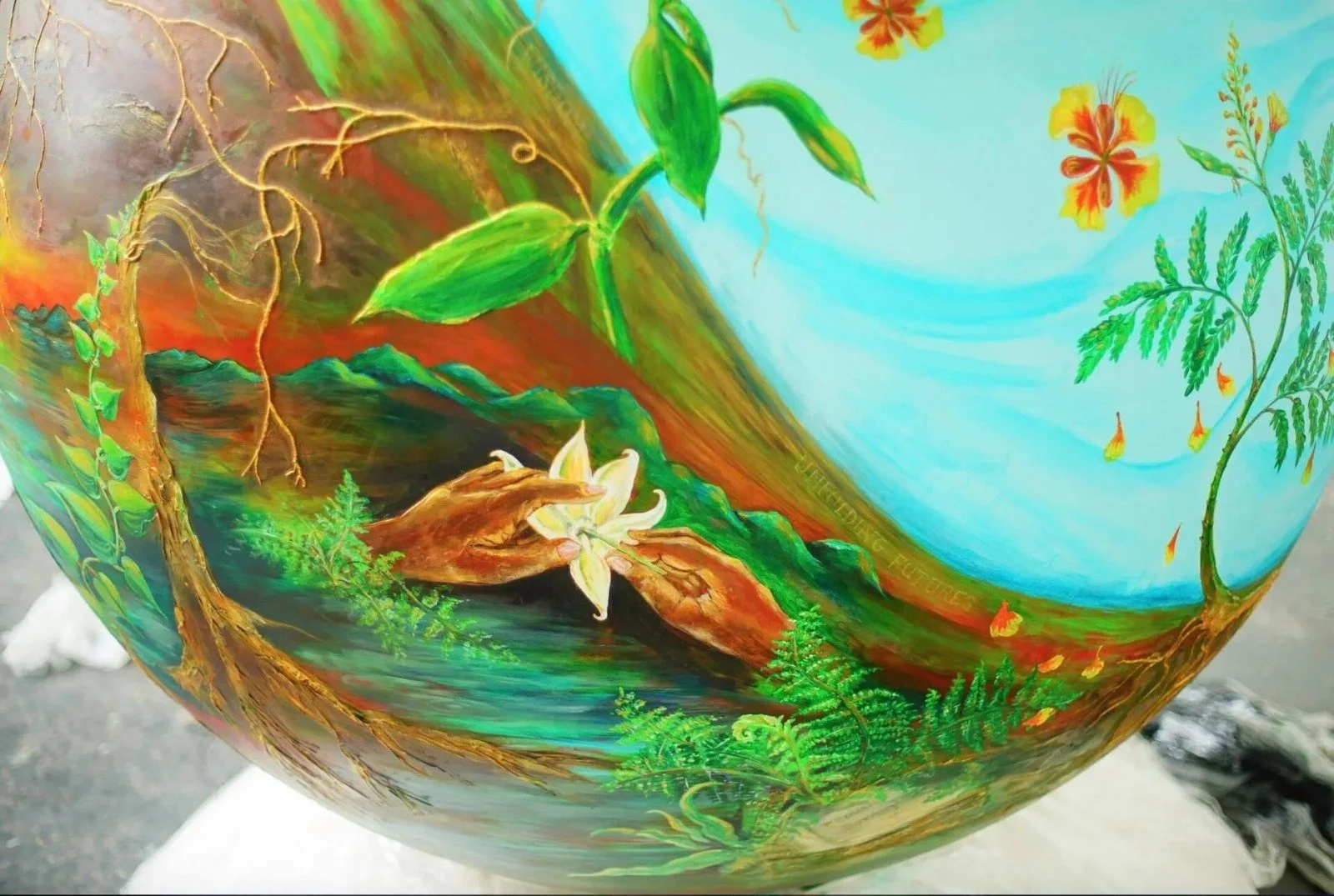The Intertwined Fates of Plants and History | Through the Lens of Carol Sorhaindo | The World Reimagined Art Residency UK
Ms Sorhaindo in her studio space at Hospitafield
Take a deep breath in, hold it to four counts, then let it out. Look around you. There are sounds, you see people, scenery, architecture, you feel the earth beneath your feet. But all around, there is life. Verdantly living in the form of plants. And it is certainly not far-fetched that perhaps every plant you see has played some role in Caribbean heritage. Artist Carol Sorhaindo definitely believes so.
Carol was born in England but grew up in Dominica well into her teens. It was only then, during the 70s that she left the island to pursue education in England. Though she always longed to return to the place she first called home. Carol studied Interior and Exhibition Design at HND level in the UK and then worked in the industry for five years. She then freelanced as a community artist and art tutor until 2009. In 2015, she decided to refocus on art and successfully completed her MA in Creative Arts with a focus on textiles, natural dyes, and heritage landscapes. In 2018, Carol returned to Dominica where she continued to grow as an artist. Her incredible work mainly focuses on the intricate bond between entanglement, cultural heritage and history. She finds it interesting and rather ironic that her work is woven into her own life “Home migration is a big theme in my work, roots and uprootedness. I work with plants and it’s kind of a metaphor. I’m very interested in plants and their story.”
Ms Sorhaindo came across the open submission to The World Reimagined Art Residency. In an interview done with the artist, she admitted that she felt a bit hesitant regarding applying to the programme. “As an artist sometimes you just don’t feel entirely encouraged.” And because of this, among other projects, she did not apply. However, it was not long before she was contacted directly by the organisation, particularly requesting her attendance. Carol was ecstatic and deeply grateful for the opportunity to be invited. With pleasure, she accepted the invitation to the six-week residency in England and Scotland.
“Going back to England for residency was very interesting because it was sort of a home away from home.” Having her heart tied to two places and calling them home, Carol often reflects on the meaning of home and how it relates to herself. From her online journal of the residency, she says, “'Home' is something I reflect as I explore concepts of up rootedness and migration which inform my practice. Reflection on how I connect to both the Dominica and the United Kingdom as ‘Home’ is inevitable with the Caribbean having such an entangled colonial history” She feels connected to the island, drawn to the place she relishes calling home, where her roots are intertwined with everything it has to offer.
A teaser of the finished project
The World Reimagined is an innovative national art education project that aims to express and transform the perception of the Trans-Atlantic Slave Trade and its grievous impact. In doing so, they believe that art is a powerful medium for storytelling and advocacy. For this residency, each artist had to choose a theme that corresponded with the mission of the project. Naturally, Carol chose plants. Specifically, she chose plants which had significant historical value in the lives of the enslaved.
Her (unreleased) work takes the form of a globe featuring these varying plants, all linked in a panorama along the globe with the use of textiles, acrylics, and other artistic mediums. Some of the aforementioned plants include Vanilla, Sugarcane, Pride of Barbados, Ferns, Cotton and many more. We had the privilege of speaking to the artist about some of these plants and their significance to her vision;
Carol’s vision board
Vanilla
Did you know that an ingenious enslaved boy propelled the science of artificial pollination? Indeed. Edmond Albius was a 12-year-old-boy of Réunion who realised that he could pollinate the hermaphroditic vanilla orchid by simply using a blade of grass and his thumb. This idea revolutionised the vanilla industry due to its efficiency. However, Edmond was never given credit for the technique that many had failed to procure before him. Albius was never offered great earnings from the massively successful industry and when slavery was abolished, he found work as a kitchen boy. A robbery curtailed the duration of his short career when he was blamed and sentenced to prison. He was released after five years and died at the age of 51, not having received recognition for his monumental contribution to the world. To this day, the pollination technique is still being used.
Pride of Barbados
During the period of slavery, many of the enslaved expressed their grievances with forms of resistance. For instance, some of the enslaved women would consume the seeds of the Pride of Barbados as an abortifacient. The women believed that by inducing abortions, they were saving their unborn children from the injustices and cruelties to which they had been subjected to.
Arrowroot
The starchy rhizome is one that many from the Caribbean have eaten and heard of. Whether as a warm porridge as a child or a thickener in soup. However, the plant comes with more benefits than just a warm fulfilling tummy. Arrowroot was used by the native Amerindians as a poultice for wounds, cuts, poisons, and sores. The mineral-rich staple can also be used to treat or prevent health issues such as Irritable Bowel Syndrome and Urinary Tract Infections. Today, many still consume the crop regularly. It has even become a means of export revenue for some Caribbean countries in the form of flour.
Ms Sorhaindo looks forward to sharing the completed product of the commission once released in August. Currently, she resides in Dominica where she is an active member of WAA and continues to grow as an artist and an individual.
More from the Artist!
Website: http://www.carolsorhaindoartist.com
Facebook: https://www.facebook.com/Carol-Sorhaindo-Artist-257692907587997/?fref=ts
Instagram: @carolsorhaindo
See for more information:
Arrowroot: A Caribbean starch. SPICEography. (2022, February 21). Retrieved July, 2022, from https://www.spiceography.com/arrowroot/
Melbourne, L. (2019, October 16). Edmond Albius: the boy who revolutionised the… | The Linnean Society. The Linnean Society; www.linnean.org.https://www.linnean.org/news/2019/10/16/edmond-albius
Schiebinger, L. (2004). Plants and Empire: Colonial Bioprospecting in the Atlantic World. Cambridge, MA : Harvard University Press. https://doi.org/10.2307/j.ctvk12qdh



